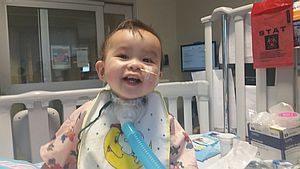A Life-Saving Surgery Only Few Can Perform
When 6-month-old Jullia started getting croup, back-to-back, every month, Jullia's parents, decided to put their faith in the doctors at CHAM. Hard working immigrants from Vietnam, all they knew was that their daughter kept getting sick and they didn’t understand why. In August of last year, Jullia's pediatrician, Dr. Thais Castillo, decided to refer her Pediatric Otorhinolaryngology (Ear, Nose, and Throat). Shortly thereafter, Jullia was hospitalized for croup.

It was September when I first met with Jullia and her pediatric team in the hospital. After myself and Dr. Giselle Barraza, a Pediatric Pulmonologist (lung specialist) discussed Jullia's condition, we decided to perform a joint bronchoscopy to examine her airways. At that time, we discovered she had a small subglottis, just below her vocal cords. Over the next few days, Jullia's condition showed improvement and she was discharged home.
Things were going well until the holidays when Jullia came down with another viral illness. This time she did not get better in a few days. Jullia was in the pediatric intensive care unit (PICU) for several weeks in December and January. It was during that time when Jullia’s care team performed multiple tests to figure out why. A CAT scan and subsequent bronchoscopy detected a second and more severely combined airway problem: Jullia was suffering from a rare and potentially fatal condition that was compromising her respiratory function. Without surgical intervention, she could die. Making the problem more difficult were Jullia's anomalous airways that branched twice to her right lung, above and below the narrowest portion of her airway. from the severe airway narrowing was due to complete tracheal rings, causing the lower half of her airway to be half as wide as they should have - only been 2mm instead of 4mm across - and a pulmonary artery sling wrapping around this segment, further compressing the already tiny airway.
Thankfully, cardiothoracic surgeon Dr. Giles Peek and I were trained at two of the best worldwide centers for the precise, life-saving procedure that was going to keep Jullia alive. After she recovered from her viral illness and before she was likely to get sick again, the pediatric cardiology, pediatric cardiac anesthesia, pediatric critical care, and pediatric pulmonology teams worked swiftly with our pediatric cardiothoracic surgery and pediatric otorhinolaryngology teams to plan an intrathoracic slide tracheoplasty and pulmonary artery sling repair on cardiopulmonary bypass procedure and a precise month-long postoperative plan.
On March 10, we completed a slide tracheoplasty, pulmonary artery sling repair, and tracheostomy and were prepared to host Jullia's stay for approximately one month post-surgery in the ICU. Sometimes, patients with complete tracheal rings and pulmonary artery sling, like Jullia, end up on the heart-lung bypass machine before and after surgery. They often experience difficulty with mucous plugs blocking the airway or scar tissue narrowing the surgical repair. Within 3 days, we were quite happy to awaken her and wean her off the ventilator. Every week we monitored her airway by bronchoscopy. We were delighted to see that she healed quickly without any of the common complications from airway surgery.
For the first time in months, Jullia was able to breathe comfortably. Every day she made progress. By Week One, she was able to get out of bed. By Week Two, she had a smaller tracheostomy tube and was gleefully dancing to Adele. By Week Three, we began plans for discharge, including diet modifications and capping her tracheostomy tube. On April 8, one month after surgery, we removed her trach tube and Jullia was discharged home.
I am so proud to have been a part of the team that saved Jullia's life and to have the expertise and surgical training to have repaired Jullia’s airway. I chose to join Montefiore for our commitment to excellent patient care, especially for children and adults like Jullia who could have otherwise gotten lost in the shuffle. I am especially thankful for the specialized, multidisciplinary care we offer, for our aerodigestive team’s timely diagnosis and evaluation, the PICU nurses and respiratory therapists who took such good care of her airway, especially during the crucial first three weeks after surgery,and the social workers who arranged disposition plans and conducted family meetings with all specialties and Vietnamese interpreters present. Mom and Dad proved quite resilient and dedicated through this process, despite the hardships of a long hospitalization and a sometimes frustrating language barrier.
Today, her airway is now twice as wide as it had been. Unlike other children faced with similar problems, Jullia thankfully did not develop narrowing along her stitches or mucous plugs that could obstruct her airway. She runs around with other children without any limitation now. I look forward to seeing Jullia blossom into a young woman who can play, run, sing, dance - and do anything she so desires to do in life.